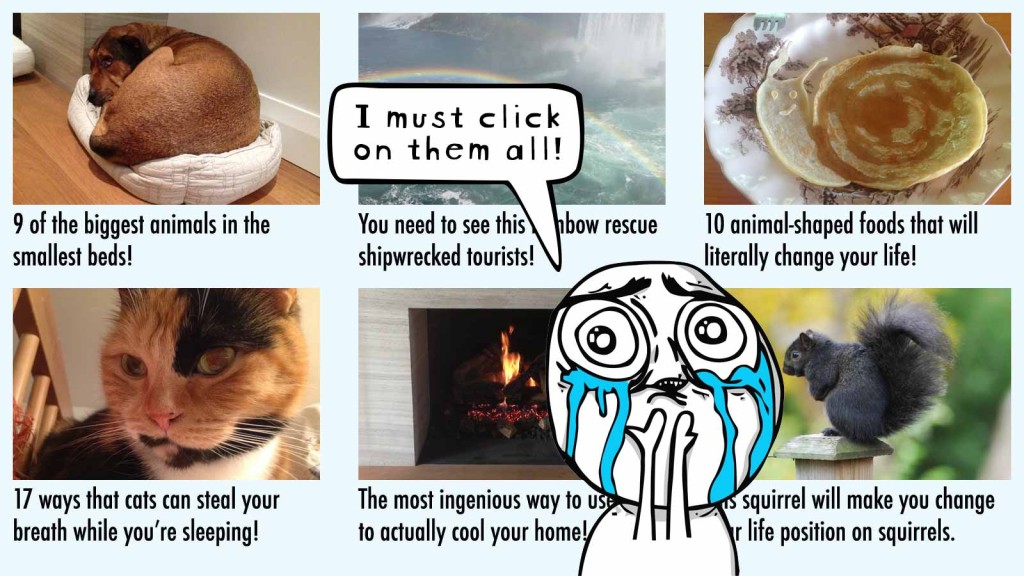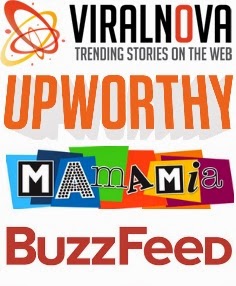Writes Buffer:
Most people have the same experience with “clickbait.”
You stumble across it in your Facebook feed or Twitter feed. It reads, “13 Problems Every Blonde Bostonian Working at a Marketing Software Company Has.” You recognize it’s pandering to you … but it’s just so perfectly intriguing, you have to click. You click, resigning yourself to scrolling through for just a minute because you’ve got work to do. You get to the first list item — it’s roughly on point, so you continue.
Suddenly, 10 minutes go by — you’ve scrolled through the whole article and realized it’s a load of crap that was meant to waste your time. You hate yourself a little. You get back to work, telling yourself you won’t get duped again. You’re too smart for that … but sure enough, an hour later, the whole clickbait-shame cycle continues.
Don’t be upset — it’s happened to pretty much everyone. Clickbait has been around for over a century, and it’s remained a common tactic for content creators because it works. As a content creator, it’s one of those ethical grey areas you have to navigate.
To help you figure out which side of the clickbait debate you fall on, we put together this post — hopefully, by giving you some background into the history, science, and ethics of clickbait, you can make a decision on how you’re going to create content for your company.
Learn more about its History...READ MORE
We like Think Christians summation of what ClickBait really is in its rawest form:
[As the New York Times‘ Maria] Konnikova boils the appeal of such headlines down to two qualities: positivity and arousal. Click bait tempts us with content that will either make us feel good or just feel something – be it compassion, amusement, anger or incredulity. Look at the headlines listed above. They promise disbelief, amazement, emotional destruction, understanding and social bonding. They all say, “This will make you feel.”
Furthermore, these headlines insert you, the reader, into the story. Note the subjects: I, me, my, I, I, I, us. These headlines reorient the stories behind them so they aren’t really about their subjects. The stories are about your reaction to them. The stories exist for you. It’s all about you.
On one level, I admire the honesty of click bait. Such headlines are the “selfies” of online journalism. Selfies strip away the facade. Forget hiding your intentions behind comments or check-ins. When you post a selfie, you say resolutely, “I want you to look at me.” Click bait is a media outlet’s way of saying, “We want you to believe this is about you, because we want your clicks.”
But first….Engagement labs summarizes Outrageously Simple Steps to creating :
1. Create Lists – Everyone loves lists, they are easy to understand and usually signal that the content is going to be brief.
2. Keep it Short and Sweet – We’ve all clicked on an interesting article that turned out to be a long essay, only to abandon it halfway through. Long form has an important place to cement your business expertise, but for blog posts, keep it short. Concise posts invite users to keep coming back when they have a moment rather than needing to dedicate long periods of time and risk not finishing the article.
3. See What’s Trending – If there is a logical connection between a message that you hope to spread and something that is trending at the time, the integration will definitely see dividends. Can How I met your Mother teach you about networking? What does March Madness say about social media?
4. Use Killer Keywords – By creating a headline that focuses on Insane, Shocking, Horrific, Weird Facts, or other similar keywords, you are going to have an easier time breaking through the mass of content and getting noticed.
5. Open up the Rabbit Hole – One of the greatest skills these sites have is the ability to keep you clicking. It’s easy to go through three, four or ten articles in succession. By having related links at the end of your post, you provide the opportunity for users to read and share more of your content.
It’s not just those companies that built their brand on click bait.
Because even Academic journals are doing it, so writes CNET:
Which paper would you rather read: “The Gezi Park Protests: a change towards modern democracy or a fuelled backlash leading to a more rapid “Islamification” of Turkey? Exploring the effect of the protests on Turkey’s domestic and global position in a social, economic and political context.” Or: “Before you occupy that park, read this and tell me your mind isn’t blown.”
The prospect of having your mind blown is a lot more likely to get a click than a long-winded academic title. That’s the premise behind Clickbait Dissertations, a Tumblr that spices up the titles of academic papers with Upworthy-style headlines.
Academics submit their dissertation title and abstract and the Clickbait Dissertations showrunner takes a stab at turning some of them into headlines that scream for eyeballs. “The academic market is really competitive these days, and let’s face it, nobody really reads our work. So I humbly suggest that we all move towards the clickbait model of dissertation titles. My dream is one day, some poor soul will click on an Upworthy link, and end up downloading a 300 page dissertation on the history of sequins,” reads the Tumblr.
So CLICK. CLICK. CLICK AWAY!!!!




